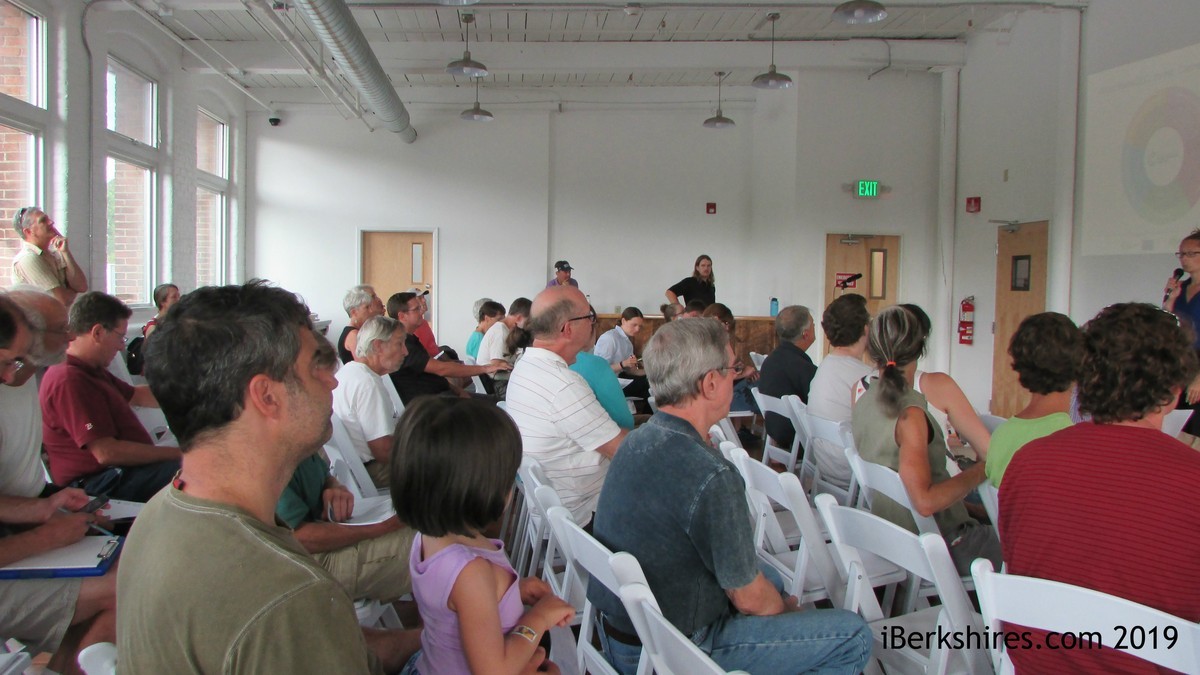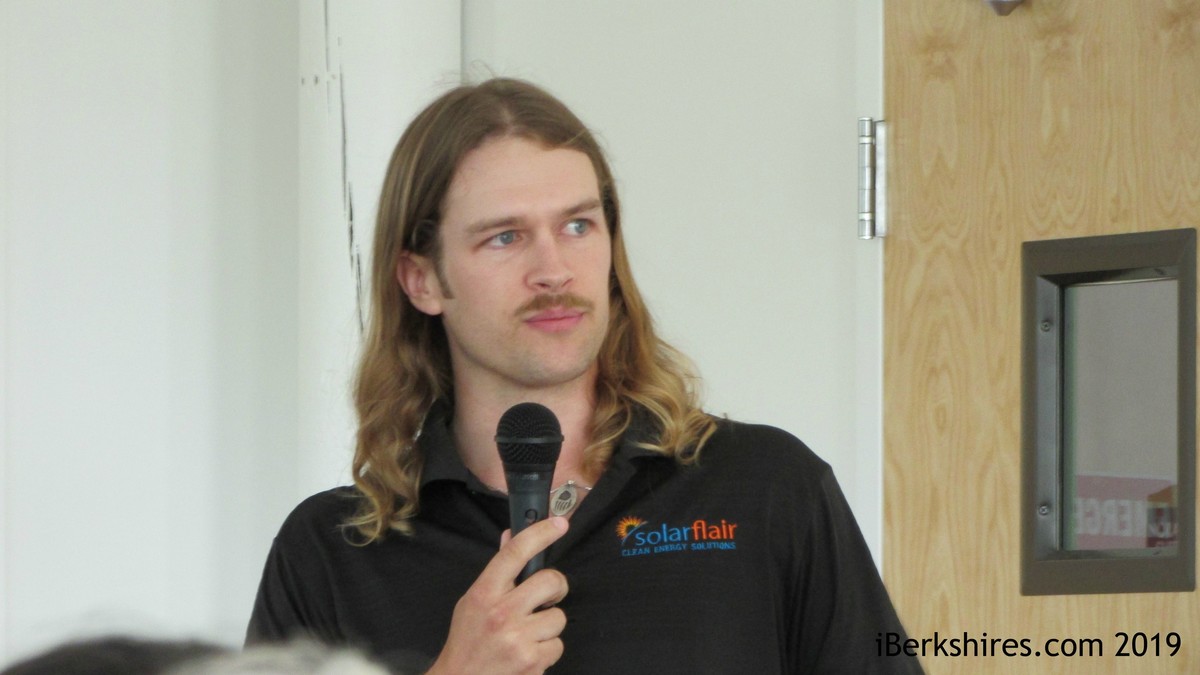Northern Berkshire Solarize Program Holds 'Meet the Installer' NightBy Stephen Dravis, iBerkshires Staff
01:17AM / Friday, August 02, 2019 | |
 A portion of the crowd of about 70 that turned out for Wednesday's presentation. A portion of the crowd of about 70 that turned out for Wednesday's presentation. |

Garrett Colvin of SolarFlair talks about the process of installing a solar photovoltaic system.
NORTH ADAMS, Mass. — North County residents and businesses have some time to enroll in the Solarize Plus program.
But if they want to take full advantage of all the economic incentives, they don't have much time.
"The [Solarize Plus] program runs through the end of the year," said Garrett Colvin of SolarFlair, the installer selected for the program in Northern Berkshire County. "Next year, the [federal] 30 percent investment tax credit drops to 26 percent.
"There's a 60- to 90-day period from signing up to installation. So to get the 30 percent, it's in your interest to meet with us sooner rather than later."
Colvin is the director of residential sales at SolarFlair and was the principal speaker at Solarize Plus North Berkshire's "Meet the Installer" night on Wednesday at the Norad Mill.
The local volunteers who are coordinating the Solarize Plus campaign along with partners at the Massachusetts Clean Energy Center and Department of Energy Resources selected Colvin's firm to be the local installer.
That means anyone who signs up under the program will be eligible to take advantage of bulk pricing for lower cost installation of solar photovoltaic arrays and batteries than an individual buyer could find on the open market.
That cost saving is just one of the financial incentives Colvin outlined for a crowd of about 70 in the mill's third-floor meeting space.
In addition to the aforementioned federal tax credit, there is a renewable energy credit from the commonwealth of 15 percent, capped at $1,000; state alternative energy certificates worth anywhere from $750 to $2,000; the Solar Massachusetts Renewable Target, or SMART, program, which pays solar electric system operators; and, of course, net metering, where electricity produced by a solar array goes back onto the grid and is credited against your electric bill each month.
Working with general numbers for a typical residential PV array, Colvin said a $20,000 system, can end up costing $13,000 out of pocket after incentives. And that could mean a 5.5-year payback period for the system.
The solar PV system has an expected life of 25 years, not counting the AC/DC power inverter, which has to be replaced after 12 to 15 years and costs between $1,000 and $3,000, Colvin said.
Even with the incentives and the bulk pricing that comes with the Solarize Plus program, the initial cost can be steep, but Colvin said there are low interest loans available to homeowners who meet income requirements.
And whether you borrow at market rate or a reduced amount, the loan you get to install solar panels also can be used toward replacing your roof -- if the installer recommends that you replace an aging roof before mounting panels.
"Part of our process is we send a site engineer out," Colvin said. "He ages the roof shingles. If we feel there is not at least 10 to 15 years left on a roof, we'll have a conversation with you about replacing the roof prior to installing PV. It might be in your interest to do that first."
The process at SolarFlair begins with a site assessment of your property by technicians who use satellite images to look at the orientation of your roof (south facing is optimal), the presence of any architectural obstructions (dormers, chimneys, etc.) and the presence of nearby trees or buildings that could shade your roof.
It is possible to do solar panel installations on slate roofs, but those home owners might want to look at other options.
If it turns out that your roof is not optimal for installing solar panels (because of shading or the roof's composition), SolarFlair also does ground-mounted units, Colvin said. That can be a little more expensive, depending on how far they have to locate the panels from the house, but there are also can be greater efficiencies with ground-mounted panels, which can be oriented more directly toward the sun and, thus, require fewer panels to get the same production.
Colvin said that SolarFlair has done more installations under the 8-year-old Solarize program.

Lisa Dobbs of the Massachusetts Clean Energy Center explains commonwealth's success in encouraging private solar installations.
"Essentially, [Solarize] is a model to simplify the process and also reduce the cost of solar electricity," Lisa Dobbs of the Massachusetts Clean Energy Center said. "The savings gets passed on to the consumer."
Dobbs said 71 communities throughout the commonwealth have organized 81 different Solarize campaigns; this is the second go-around for Williamstown, which ran its own Solarize campaign in 2013 and this year is teaming with North Adams.
"Williamstown and North Adams are blazing a trail by adding batteries and educating you about solar hot water," Dobbs said.
Although solar hot water installations are not part of the agreement with SolarFlair, the program's chosen installer, the program's "solar coaches" said Wednesday that they are working to gather names of other installers who would be available to do that work. Unlike solar arrays that turn the sun's rays into electricity, solar hot water systems use the sun's heat to warm a fluid (like water or propylene glycol) that runs into the hot water tank and can supply up to 80 percent of your hot water needs, Dobbs said.
"The next steps in getting started are to sign up for email updates, sign up for a site assessment, learn more about solar hot water when we get more information on that and sign up for an energy audit," Dobbs said. "If solar is not feasible for you, talk to the team about other options. The solar coaches will be the best lead to get in contact with the team and the installers."
The coaches on Wednesday recommended that interested property owners go directly to the SolarFlair website and click the link to Solarize Mass.
| 
 MEMBER SIGN IN
MEMBER SIGN IN
 MEMBER SIGN IN
MEMBER SIGN IN